All about Styrofoam ceiling skirting boards and their installation
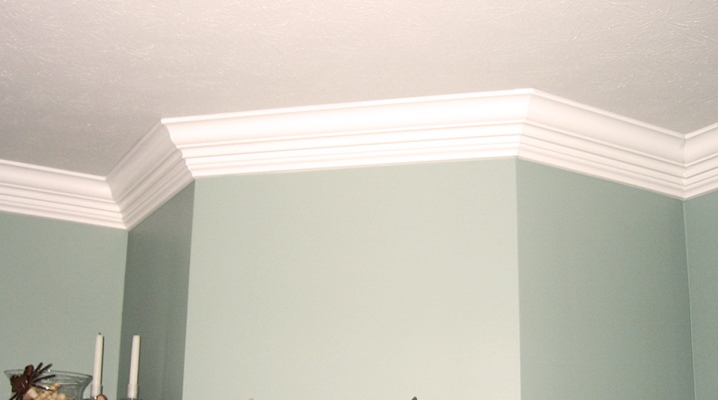
When carrying out repairs, you need to take into account many nuances in order to correctly and beautifully arrange ceilings, walls and floors. And, of course, you should know everything about Styrofoam ceiling skirting boards and their installation.
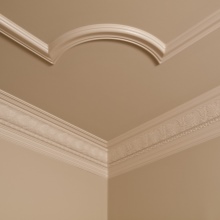
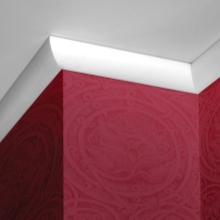
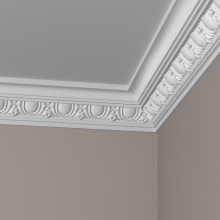
Advantages and disadvantages
Despite the fact that the modern industry produces skirting boards from various materials, foam ceiling products are very popular and in demand among the consumer. There are several reasons for this justified preference:
- foam materials are the cheapest in comparison with other analogs made of polymers, gypsum or wood;
- the material has a long service life and retains its qualities for decades;
- the installation of a foam molding is quite simple, and even an inexperienced person in the construction business can cope with such a task;
- the foam is lightweight, so one person can perform the installation of the skirting boards;
- the dimensions in width and the appearance of the skirting board design allows the use of foam material for interior decoration of any design style;
- in appearance, the foam imitates expensive gypsum stucco moldings and at the same time looks dignified and attractive, harmoniously combined with any interior;
- the material does not expand with changes in temperature and humidity levels;
- the skirting board can be painted in any color, and it can also be installed on the surface of a stretch ceiling;
- foam does not require special measures and methods of additional care;
- the material has good adhesive properties and is well mounted on painted, concrete or brick surfaces, drywall, wallpaper of any composition, plaster, and so on;
- the material is absolutely harmless to human health and does not emit harmful chemical components into the environment;
- the surface of the foam is not affected by mold or mildew.
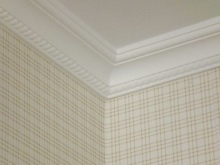
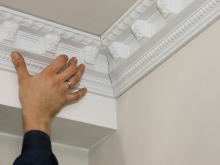
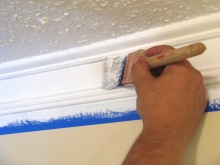
Of course, foam plastic also has a number of disadvantages, but they are so insignificant that few people pay attention to them:
- when cut, coarse-grained foam does not make it possible to make an even and beautiful joint, so the seam has to be additionally sealed with putty or acrylic sealant;
- this material dissolves under the influence of organic solvents, therefore, adhesives containing this component are not suitable for installing foam, since they burn through it;
- thin foam baguettes are fragile, therefore, when performing installation work, you will need to be careful and careful;
- over time, the foam decor may turn yellow, so it is updated by tint;
- it is possible to dismantle the glued foam plinth only by destruction, it is no longer possible to reuse this material.

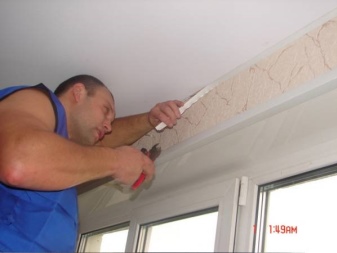
Foam finishes are versatile finishes that can be applied to any space.
It is not difficult to purchase such a decor - it is offered in a wide range in almost every specialized retail chain. The moldings look the most attractive after staining, their color can be made in accordance with the overall decoration of the room, or you can choose contrasting options.Inexpensive and versatile skirting boards look no worse than their gypsum counterparts, but they significantly save the budget and do not cause problems with self-assembly.

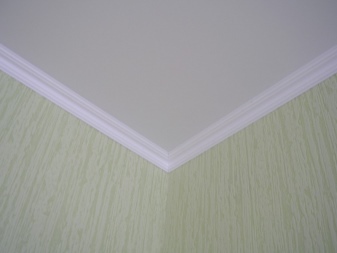
You can fix the foam plinth under the ceiling in the following cases:
- on the surface of any wallpaper - paper, liquid, vinyl, as well as those intended for painting;
- the wall can be painted with any kind of paint or simply treated with a layer of putty;
- the skirting board can be glued to the ceiling or simultaneously to the wall and ceiling.
Experienced builders glue the skirting board first, and then the wallpaper. But if you have little experience in performing such work, then it is more advisable to first stick wallpaper on the walls, and only then place the baseboards.
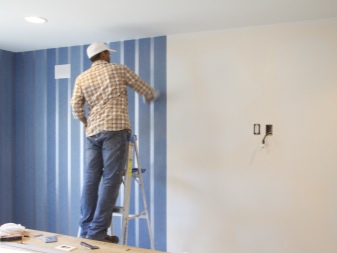
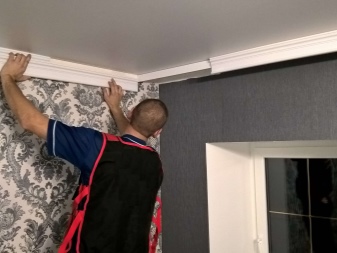
Dimensions (edit)
The lightweight foam ceiling plinth has a standard length of 2 m. The width of such products can vary - the narrowest baguette in width will be only 1.5 cm, and the wide version can reach 13 cm. In addition to the parameters of length and width, baguettes also differ in thickness. The range of this size is from 1.5 to 8.5 cm, but sometimes skirting boards with a thickness of 10 cm are also found, which are used to decorate large-sized rooms with high ceilings.
To decorate a room with a foam plinth, you must first calculate the required amount of material. For this, the room is measured along the perimeter, and an additional 2 m is added to the result for unforeseen expenses. To find out the number of planks that you need to buy, the perimeter and additional stock indicator is divided by 2, since the length of the plinth is 2 m. After performing the calculations, you can start choosing the design of the product, its width and thickness.
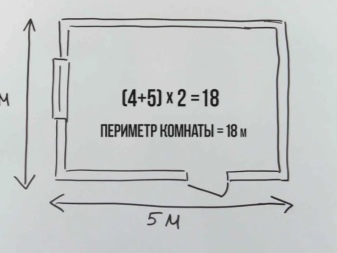
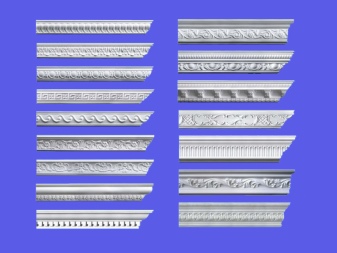
Experts believe that the width of the plinth should be chosen based on the height of the ceiling in the room.
If the ceilings are low, then narrow options are acquired for the room, and for rooms with high ceilings (at least 3 m), you can purchase a wide plinth, while it will not look heavy and will not visually hide the space between the ceiling and the floor.
Design
Styrofoam moldings have various shapes and surface decorations. Planks can imitate gypsum stucco molding by placing volumetric convex elements and geometric shapes on their front side. On the outer side of the plinth, a geometric or floral ornament is most often placed.
There are also more discreet options. You can even see completely flat baguette options on sale.
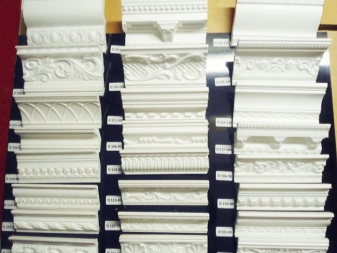
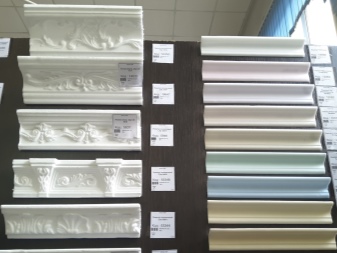
Such decorative items are divided into 2 categories: ceiling and wall. The difference between them lies in the shape of the molding. If it has an angular structure and a couple of narrow surfaces where the adhesive is supposed to be applied, then this is a ceiling option, and if the product has a wide back surface, then this is a wall plinth that can be glued to any plane. The areas of application of the two categories of foam skirting boards differ from each other. The corner baguette in decoration is used to refine the joints between the wall and the ceiling, therefore, such models have 2 surfaces for applying adhesive - one surface will be attached to the ceiling, and the second to the wall. Wall molding is attached only to the surface of the walls, but this decor is placed close to the ceiling line.
Most often, white foam baseboards are on sale, but there can also be colored ones - beige, light blue, pale green, and so on.... The moldings installed at the location can be painted. If minor damage was made during the installation process, they are eliminated with a putty.
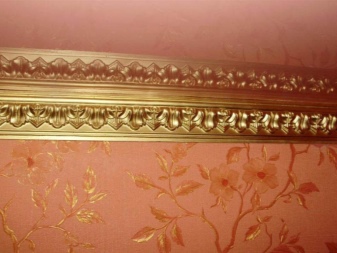
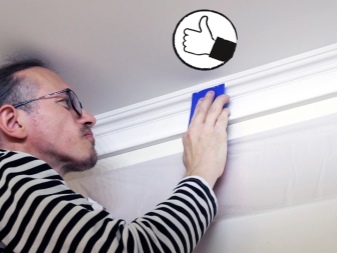
How to choose a glue?
Decorative elements made of polystyrene can be glued using any adhesive that does not contain organic solvent components. Carefully cut material should be spread with glue. The gaps in the joints between the strips are eliminated with a putty with acrylic, to which PVA glue is added. In addition, joints can be sealed with a quick-drying acrylic sealant.
When choosing the types of glue, it must be borne in mind that the foam can shrink slightly under the influence of the adhesive composition. Therefore, the joints between the skirting boards must be sealed most carefully and very tightly.
It is best to glue foam products on liquid nails - this glue has a transparent consistency and sets quickly.
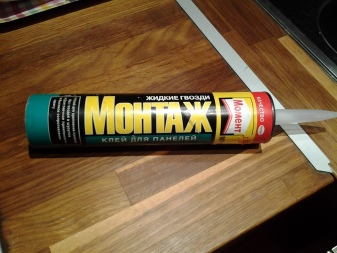
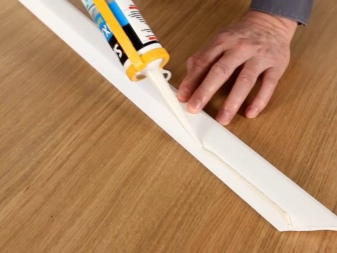
If desired, you can prepare the adhesive yourself. For this purpose, you will need to take:
- finishing dry construction putty;
- liquid PVA glue;
- some plain clean water;
- container for mixing ingredients.
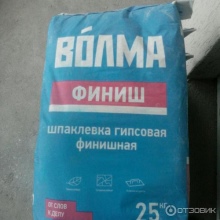

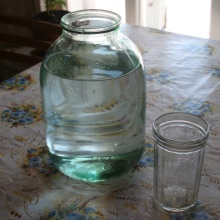
The process of preparing the adhesive is as follows:
- a certain amount of dry putty is placed in the container;
- add 1 part of PVA liquid glue to 4 parts of the putty;
- the contents are gently stirred so that lumps do not form;
- the mixture is slightly diluted with water until a semi-liquid consistency is obtained, convenient for application;
- the glue is allowed to swell for 15 minutes, after which it is thoroughly mixed again, after which the composition is ready for work.

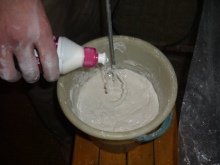
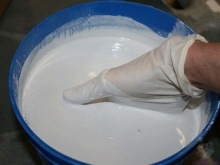
The ready-made adhesive mixture must be made in a small amount in order to have time to use it up within two hours, after which the composition will gradually lose its adhesive properties, and the quality of installation will be reduced.
If you do not want to make the adhesive yourself, you can purchase it ready-made. There is a wide range of similar adhesives in construction outlets that can be used for the installation of foam fillets. It is worth noting that each type of adhesive has its own characteristics.
- Acrylic adhesive on a water base has a long drying time, it cannot be used if the room where the work is being performed has a negative temperature regime, or it has not been heated for a long time. The adhesive does not have an unpleasant odor and can be used in rooms where ventilation is not possible.
- Liquid Nails - a universal polymer product with fast adhesion, which is convenient to apply to work surfaces (it does not spread). According to the speed of solidification, polymer compositions are divided into instant and gradual.
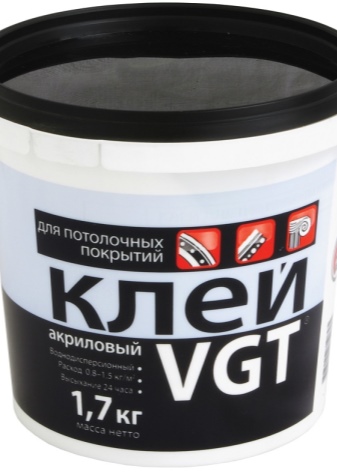

Let's note the most common adhesives that are used for gluing foam plinths to the ceiling surface.
- Glue "Moment" has a fast solidification, however, at the time of installation, the glue mass makes it possible to correct the position of the fillet and align it relative to the line of the ceiling or wall. After a short period of time, the glue hardens completely and firmly.
- Glue "Titan" has a gradual, long hardening period, but is quite suitable for mounting foam plinths to a wall or ceiling surface. After applying glue to the surface, the workpiece must be pressed against the wall and held for 5-7 minutes, for this reason, the installation work time is significantly increased.
- Glue "Eco-set" has a gradual hardening and requires a long pressing of the plinth to the surface to be decorated. The adhesive does not contain any harmful components and is not hazardous to health.
- PVA glue - consists of polyvinyl acetate, which is a polymer. This component does not corrode the foam and can be used for its installation. PVA glue is harmless to human health, but it has a gradual solidification, so it takes a lot of time for installation work. In addition, for strong adhesion, a large amount of adhesive must be applied to the surface of the skirting board, otherwise the skirting board may not stick to the wall or ceiling.
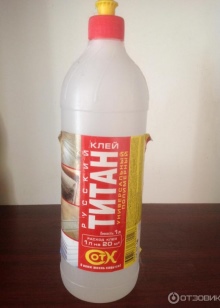
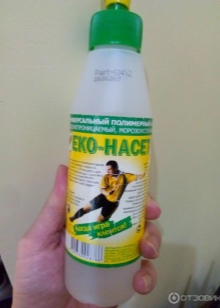
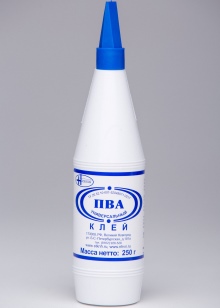
When choosing an adhesive composition, you need to focus on its quality, hardening speed, adhesion strength and cost.In addition, the temperature regime in the room being decorated is taken into account, which is suitable for a particular adhesive composition.
How to install?
Installation of a foam plinth on a wall or ceiling can be done by hand, since the installation of this finishing material does not present any particular difficulties and is done quickly enough. When working with polystyrene, it must be remembered that this is a fragile material, and careless actions can lead to the fact that the baguette breaks during installation. The finish looks beautiful and neat only if the moldings are properly glued to the wallpaper, even vinyl, as well as to putty or to a stretch ceiling. To go around the corner, the foam cannot be bent - the cornices will have to be cut at an angle of 45 °, and then the seams and crevices are covered with white acrylic sealant.
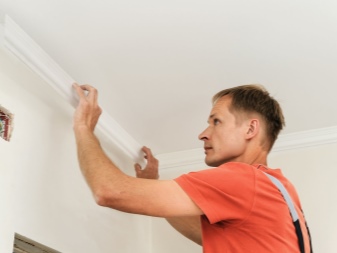
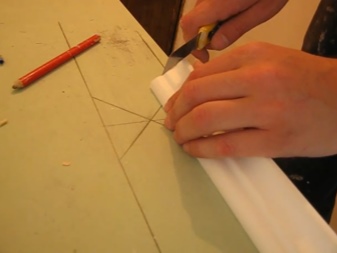
Instruments
Before you start gluing baguettes, you need to make preparatory work and stock up on the necessary tools.
- You can cut the styrofoam trim moldings with a sharpened knife or use a fine-toothed hacksaw for this purpose. An ordinary hacksaw designed for metal processing is best suited for work. A baguette, the width of which does not exceed 20 mm, is more convenient to cut with a knife. Scissors are not used for these purposes, as they pinch the edges of the parts and deform them.
- In the process, you will need to cut the plinth to decorate the corners - external and internal. To facilitate such a task, a special device called a joiner's miter box will help. With it, you can easily cut the material at an even 45 ° angle. If the corner has a different size, then the marking of the baguette is performed at the attachment point. To do this, first one plank is brought to the wall and the angle is marked, and then the second plank is brought to another adjacent wall and the cut angle is also marked. After that, the strips must be removed and already cut along the marks.
- Small rubber trowel for applying and leveling adhesive. Excess glue can be removed with a spatula.
- Zero grit sandpaper. It is necessary for sanding surfaces after processing them with a putty, for example, when joining corners or when restoring minor damage to the material.
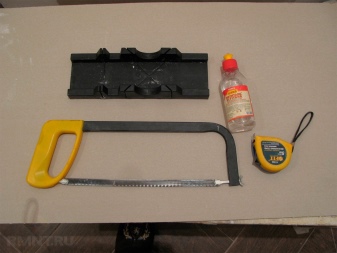
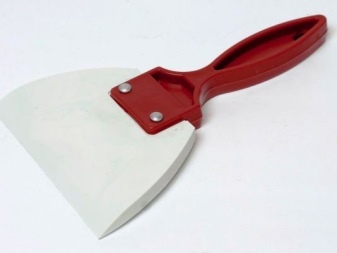
For work, it is worth stocking up on a clean and dry cloth, which should always be at hand in order to have time to remove excess glue that protrudes onto the front side of the plinth during installation in time.
Preparation
Fastening the foam decor to the ceiling or wall surface is performed step by step in a certain way.
Before decorating, you should carefully examine the ceiling and wall sheets. It is necessary to eliminate minor defects and level the surface in advance. It is especially important that the working surfaces are even when installing a narrow plinth, since in this case it will not be easy to hide the flaws in the bearing surface.
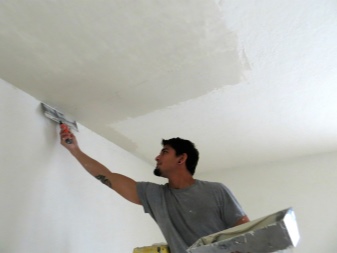
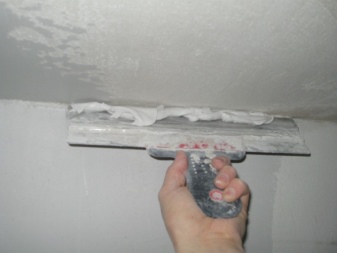
After the surfaces have been leveled, further work needs to be done.
- Prime the surface with a liquid primer and wait until the composition is completely absorbed and dries well. This is necessary in order for the adhesion of the adhesive to be as high as possible.
- On the working surface, markings are performed using a pencil. For this, the plinth is applied to the attachment point and notes are made. The joints must also be clearly marked so that during gluing it is not necessary to level the skirting board.
- It is necessary to cut 2-meter baguettes so that the joints of the material are as small as possible - this is the most crucial stage of the preparatory work. The layout of the moldings can be thought out in advance and the layout of the material can be drawn on paper to see where the joints will be located and adjust them before cutting.
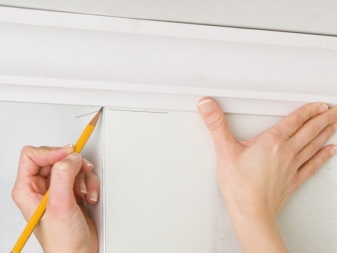
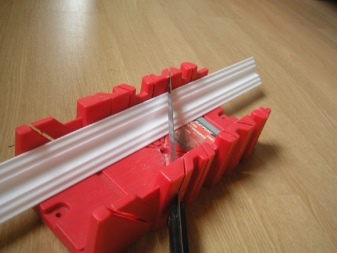
After the cutting is completed, you can proceed to the installation work.
Fastening process
If you plan to glue the foam plinth over the wallpaper, then it is necessary that they be fixed to the wall firmly enough, otherwise the decor may fall off along with the piece of wallpaper.
Rules to follow when gluing skirting boards.
- The adhesive composition is required to be applied to the skirting board in an even layer, without missing a single section. The thickness of the layer is chosen based on the thickness of the material and its width.
- The glue is applied from the middle of the plinth, and then the entire mass is distributed to the edges to the right and left.
- It is necessary to apply the foam plinth to the wall carefully so as not to crush the fragile material during pressing and not to leave traces of indentation on it.
- The retention period in the pressed state depends on the brand of glue, which should be indicated in the instructions for the composition.
- Pay special attention to the joints of the material - they must be neat.
- Remove the glue that has appeared on the front side in time, since after its polymerization it will no longer be possible to eliminate the smudges.
- Allow the pasted decor time and conditions for the adhesive to dry completely. This usually takes at least 24 hours.
- Docking seams can be started to be sealed with white acrylic sealant only after the glue dries out after a day and the plinth is firmly fixed in place.
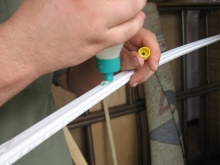

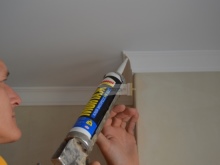
In the case when there are many joints, experts recommend priming the baseboard, and then painting it with acrylic paint, so the flaws will be less visible.
The gaps that remain must be covered with a sealant, and then treated with fine-grained emery paper.
In some cases, the joint seams may separate slightly after a few months after installation. This is due to the shrinkage of the material. In this case, they will have to be re-treated with a sealant or putty.
If you want to glue foam skirting boards to the surface of a stretch ceiling, then narrow and light options are suitable for this purpose. Moreover, you need to choose a plinth, in which the upper part has a ledge for attaching it to the ceiling.
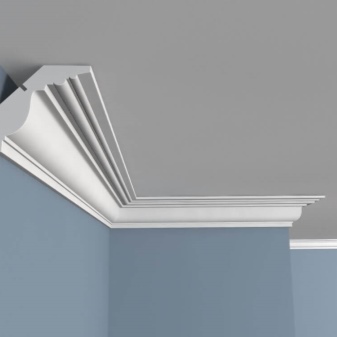

Beautiful examples in the interior
The ceiling decor, made of foam material, looks advantageous in rooms for various purposes. With the help of such finishing, the interior space acquires a special completeness and harmony.
- The application can not only be limited to the junction of the wall with the ceiling, but also go to the surface of the ceiling, for example, in the form of a decorative rosette decorating the place where the chandelier is attached.
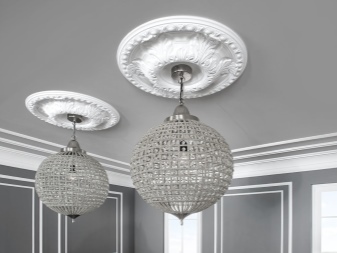
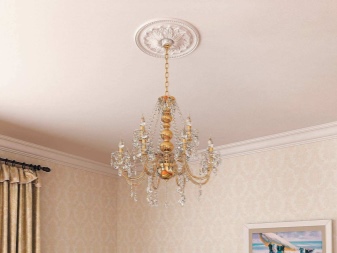
- White wide molding looks aesthetically pleasing, which contrasts with the dark-colored wallpaper. This finish allows you to visually expand the room, and the level of the ceiling seems much higher than it really is.
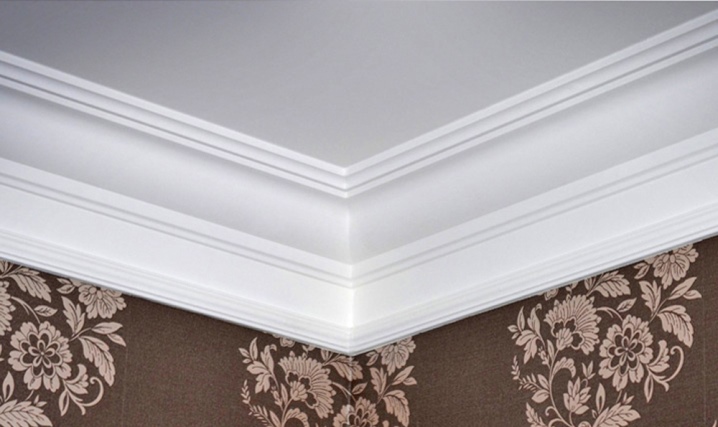
- Foam plates, placed across the entire surface of the ceiling, replace traditional whitewashing or staining. This method is budgetary, but original. A wide baguette completes the composition and harmoniously matches it with the external appearance of the walls.
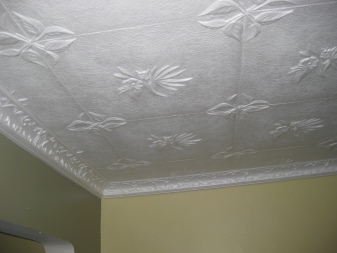
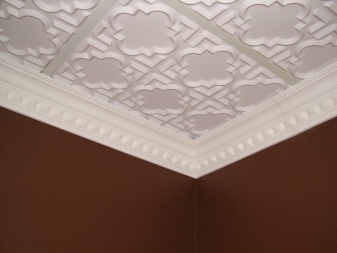
- With the help of high quality foam, you can simulate volumetric gypsum stucco molding. But unlike gypsum, foam plastic weighs several times less, and its cost is much lower. The appearance of the room with trim moldings acquires a special chic and originality.
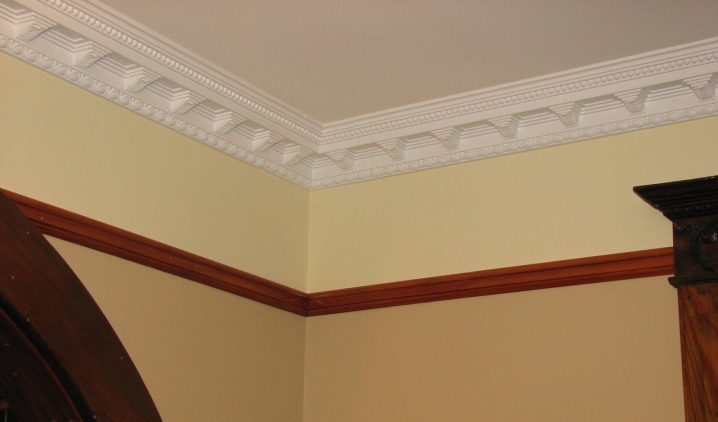
- Wall and ceiling moldings can be skillfully combined with each other and used in room decoration. The result is a unique and distinctive design solution that decorates the interior, combined with the rest of the decor elements.

Foam decorative skirting boards give a lot of room for creative imagination and allow you to decorate a room of any type and purpose in an original way. Due to the availability and rich selection, foam finishing products are in great demand among consumers.
Even with a modest budget, any room can be designed so that it looks expensive and stylish.


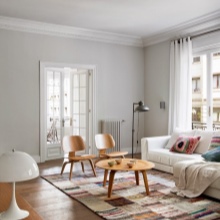
For how to easily and quickly glue the ceiling plinth, see the next video.













The comment was sent successfully.